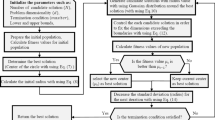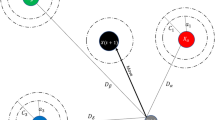Abstract
Population-based optimization methods are frequently used in solving real-world problems because they can solve complex problems in a reasonable time and at an acceptable level of accuracy. Many optimization methods in the literature are either directly used or their binary versions are adapted to solve binary optimization problems. One of the biggest challenges faced by both binary and continuous optimization methods is the balance of exploration and exploitation. This balance should be well established to reach the optimum solution. At this point, the galactic swarm optimization (GSO) framework, which uses traditional optimization methods, stands out. In this study, the binary galactic swarm optimization (BinGSO) approach using binary artificial algae algorithm as the main search algorithm in GSO is proposed. The performance of the proposed binary approach has been performed on uncapacitated facility location problems (UFLPs), which is a complex problem due to its NP-hard structure. The parameter analysis of the BinGSO method was performed using the 15 Cap problems. Then, the BinGSO method was compared with both traditional binary optimization methods and the state-of-the-art methods which are used on Cap problems. Finally, the performance of the BinGSO method on the M* problems was examined. The results of the proposed approach on the M* problem set were compared with the results of the state-of-the-art methods. The results of the evaluation process showed that the BinGSO method is more successful than other methods through its ability to establish the balance between exploration and exploitation in UFLPs.






Similar content being viewed by others
References
Islam M (2020) Optimization of the critical production process in a textile factory using AHP. Department of Mechanical and Production Engineering, Islamic University of Technology
Kotary J et al (2021). End-to-end constrained optimization learning: a survey. arXiv preprint arXiv: https://arxiv.org/abs/2103.16378
Krause J et al (2013) A survey of swarm algorithms applied to discrete optimization problems. Swarm intelligence and bio-inspired computation. Elsevier, pp 169–191
Zhan Z-H et al (2021) A survey on evolutionary computation for complex continuous optimization. Artif Intell Rev. https://doi.org/10.1007/s10462-021-10042-y
Christensen HI et al (2016) Multidimensional bin packing and other related problems: a survey
Salkin HM, De Kluyver CA (1975) The knapsack problem: a survey. Nav Res Logist Q 22(1):127–144
Turkoglu D C, Genevois M E (2020) A comparative survey of service facility location problems. Ann Oper Res 292(1):399–468. https://doi.org/10.1007/s10479-019-03385-x
Kong XY et al (2015) A simplified binary harmony search algorithm for large scale 0–1 knapsack problems. Expert Syst Appl 42(12):5337–5355
Hussien AG et al (2020) New binary whale optimization algorithm for discrete optimization problems. Eng Optim 52(6):945–959
Chen Y, Xie WC, Zou XF (2015) A binary differential evolution algorithm learning from explored solutions. Neurocomputing 149:1038–1047
Beheshti Z, Shamsuddin SM, Hasan S (2015) Memetic binary particle swarm optimization for discrete optimization problems. Inf Sci 299:58–84
Dhiman G, Oliva D, Kaur A, Singh K K, Vimal S, Sharma A, Cengiz K (2021) BEPO: a novel binary emperor penguin optimizer for automatic feature selection. Knowl Based Syst 211:106560. https://doi.org/10.1016/j.knosys.2020.106560
Jiang F et al (2017) A new binary hybrid particle swarm optimization with wavelet mutation. Knowl-Based Syst 130:90–101
Wang L, Zheng XL, Wang SY (2013) A novel binary fruit fly optimization algorithm for solving the multidimensional knapsack problem. Knowl-Based Syst 48:17–23
Ozturk C, Hancer E, Karaboga D (2015) A novel binary artificial bee colony algorithm based on genetic operators. Inf Sci 297:154–170
Gölcük İ, Ozsoydan F B (2020) Evolutionary and adaptive inheritance enhanced grey wolf Optimization algorithm for binary domains. Knowl-Based Syst 194:105586. https://doi.org/10.1016/j.knosys.2020.105586
Luo K, Zhao Q (2019) A binary grey wolf optimizer for the multidimensional knapsack problem. Appl Soft Comput 83:105645. https://doi.org/10.1016/j.asoc.2019.105645
Kaya E, Kiran MS (2017) An improved binary artificial bee colony algorithm. In: 2017 15th international conference on ict and knowledge engineering (Ict&Ke) pp 29–34
Kiran MS, Gunduz M (2013) XOR-based artificial bee colony algorithm for binary optimization. Turk J Electr Eng Comput Sci 21:2307–2328
Bas E, Ulker E (2020) A binary social spider algorithm for continuous optimization task. Soft Comput 24(17):12953–12979
Hakli H, Ortacay Z (2019) An improved scatter search algorithm for the uncapacitated facility location problem. Comput Ind Eng 135:855–867
Nezamabadi-pour H (2015) A quantum-inspired gravitational search algorithm for binary encoded optimization problems. Eng Appl Artif Intell 40:62–75
Ghosh D (2003) Neighborhood search heuristics for the uncapacitated facility location problem. Eur J Oper Res 150(1):150–162
Yanasse HH, Soma NY (1987) A new enumeration scheme for the knapsack-problem. Discret Appl Math 18(2):235–245
James RJW, Nakagawa Y (2005) Enumeration methods for repeatedly solving multidimensional knapsack sub-problems. IEICE Trans Inf Syst 88(10):2329–2340
Lalami ME, El-Baz D (2012) GPU implementation of the branch and bound method for knapsack problems. In: 2012 IEEE 26th International parallel and distributed processing symposium workshops and phd forum. pp 1769–1777
Tohyama H, Ida K, Matsueda J (2011) A genetic algorithm for the uncapacitated facility location problem. Electron Commun Jpn 94(5):47–54
Kennedy J, Eberhart RC (1997) A discrete binary version of the particle swarm algorithm. Smc '97 conference proceedings. In: 1997 IEEE international conference on systems, man, and cybernetics. 1–5: 4104–4108
Greistorfer P, Rego C (2006) A simple filter-and-fan approach to the facility location problem. Comput Oper Res 33(9):2590–2601
Cinar AC, Kiran MS (2018) Similarity and logic gate-based tree-seed algorithms for binary optimization. Comput Ind Eng 115:631–646
Korkmaz S, Babalik A, Kiran MS (2018) An artificial algae algorithm for solving binary optimization problems. Int J Mach Learn Cybern 9(7):1233–1247
Korkmaz S, Kiran MS (2018) An artificial algae algorithm with stigmergic behavior for binary optimization. Appl Soft Comput 64:627–640
Jaramillo JH, Bhadury J, Batta R (2002) On the use of genetic algorithms to solve location problems. Comput Oper Res 29(6):761–779
Forestiero A, Mastroianni C, Spezzano G (2005) A Multi-agent approach for the construction of a peer-to-peer information system in grids. Self-Organization Auton Inform 135:220–236
Forestiero A, Mastroianni C, Spezzano G (2008) Building a peer-to-peer information system in grids via self-organizing agents. J Grid Comput 6(2):125–140
Dressler F, Akan OB (2010) A survey on bio-inspired networking. Comput Netw 54(6):881–900
Dujardin E, Mann S (2002) Bio-inspired materials chemistry. Adv Eng Mater 4(7):461–474
Eberhart RC, Shi YH (2001) Particle swarm optimization: developments, applications and resources. In: Proceedings of the 2001 congress on evolutionary computation.1, 2: 81–86
Dorigo M, Birattari M, Stutzle T (2006) Ant colony optimization. IEEE Comput Intell Mag 1(4):28–39
Karaboga D, Basturk B (2008) On the performance of artificial bee colony (ABC) algorithm. Appl Soft Comput 8(1):687–697
Yang X-S (2009) Firefly algorithms for multimodal optimization. In: International symposium on stochastic algorithms. Springer
Uymaz SA, Tezel G, Yel E (2015) Artificial algae algorithm (AAA) for nonlinear global optimization. Appl Soft Comput 31:153–171
Zhang XD et al (2016) Binary artificial algae algorithm for multidimensional knapsack problems. Appl Soft Comput 43:583–595
Chen J et al (2009) Optimal contraction theorem for exploration-exploitation tradeoff in search and optimization. IEEE Trans Syst Man Cybern Part A-Syst Hum 39(3):680–691
Muthiah-Nakarajan V, Noel MM (2016) Galactic swarm optimization: a new global optimization metaheuristic inspired by galactic motion. Appl Soft Comput 38:771–787
Kaya E, Uymaz SA, Kocer B (2019) Boosting galactic swarm optimization with ABC. Int J Mach Learn Cybern 10(9):2401–2419
Nguyen BM et al (2020) Hybridization of galactic swarm and evolution whale optimization for global search problem. IEEE Access 8:74991–75010
Kennedy J, Eberhart R (1995) Particle swarm optimization. In: 1995 IEEE International conference on neural networks proceedings. 1–6: 1942–1948
Beasley JE (1990) Or-library: distributing test problems by electronic mail. J Oper Res Soc 41(11):1069–1072
Holland JH (1992) Genetic Algorithms. Sci Am 267(1):66–72
Wilcoxon F (1945) Individual comparisons by ranking methods. Biom Bull 1(6):80–83
Friedman M (1940) A comparison of alternative tests of significance for the problem of $m$ rankings. Ann Math Statist 11(1):86–92
Yuan XH et al (2009) An improved binary particle swarm optimization for unit commitment problem. Expert Syst Appl 36(4):8049–8055
Kashan MH, Nahavandi N, Kashan AH (2012) DisABC: a new artificial bee colony algorithm for binary optimization. Appl Soft Comput 12(1):342–352
Kiran MS (2015) The continuous artificial bee colony algorithm for binary optimization. Appl Soft Comput 33:15–23
Kashan MH, Kashan AH, Nahavandi N (2013) A novel differential evolution algorithm for binary optimization. Comput Optim Appl 55(2):481–513
Engelbrecht AP, Pampara G (2007) Binary differential evolution strategies. In: 2007 IEEE congress on evolutionary computation. 1–10: 1942–1947
Cura T (2010) A parallel local search approach to solving the uncapacitated warehouse location problem. Comput Ind Eng 59(4):1000–1009
Author information
Authors and Affiliations
Corresponding author
Ethics declarations
Conflict of interest
The author of the article have no relationship (either financial or personal) with any people or organizations that can affect or bias the paper’s contents.
Additional information
Publisher's Note
Springer Nature remains neutral with regard to jurisdictional claims in published maps and institutional affiliations.
Rights and permissions
About this article
Cite this article
Kaya, E. BinGSO: galactic swarm optimization powered by binary artificial algae algorithm for solving uncapacitated facility location problems. Neural Comput & Applic 34, 11063–11082 (2022). https://doi.org/10.1007/s00521-022-07058-y
Received:
Accepted:
Published:
Issue Date:
DOI: https://doi.org/10.1007/s00521-022-07058-y




